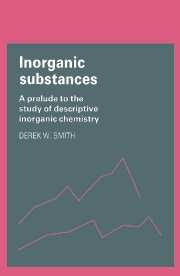Book contents
- Frontmatter
- Contents
- Preface
- 1 The theoretical framework of inorganic chemistry
- 2 Physical methods in the characterisation of inorganic substances
- 3 Nomenclature, notation and classification of inorganic substances
- 4 Periodicity and atomic properties
- 5 The occurrence of simple ions En± in crystals and solutions
- 6 Covalent bonding in Main Group chemistry: a VB approach
- 7 Molecular orbital theory in inorganic chemistry
- 8 Coordination and organometallic compounds of the transition elements
- 9 Inorganic reactions and their mechanisms
- 10 The preparation of inorganic substances
- Appendix: The literature of descriptive inorganic chemistry
- Index
10 - The preparation of inorganic substances
Published online by Cambridge University Press: 14 January 2010
- Frontmatter
- Contents
- Preface
- 1 The theoretical framework of inorganic chemistry
- 2 Physical methods in the characterisation of inorganic substances
- 3 Nomenclature, notation and classification of inorganic substances
- 4 Periodicity and atomic properties
- 5 The occurrence of simple ions En± in crystals and solutions
- 6 Covalent bonding in Main Group chemistry: a VB approach
- 7 Molecular orbital theory in inorganic chemistry
- 8 Coordination and organometallic compounds of the transition elements
- 9 Inorganic reactions and their mechanisms
- 10 The preparation of inorganic substances
- Appendix: The literature of descriptive inorganic chemistry
- Index
Summary
Introductory remarks
It need hardly be said that the preparation of inorganic substances is important in the study of descriptive inorganic chemistry. However, the diversity of inorganic substances and preparative methods defies any attempt to set out a wholly satisfactory scheme of classification. Accordingly, this chapter concentrates on examples of inorganic preparations, chosen to illustrate some of the more important points. It would be inappropriate to place much emphasis on matters of practical technique; this is best studied in the laboratory rather than in the library. Success in synthetic inorganic chemistry depends as much on manipulative skill, experience, serendipity and good luck as on a thorough knowledge of thermodynamics, kinetics and bonding theory.
Many newly-prepared inorganic substances result from thinking along the lines of ‘let's react A with B and see what happens’. Having characterised the product(s) of the reaction, further experiments may lead to improved methods of obtaining particular products. Although the substance may have been the completely unexpected product of a reaction, some degree of deliberate strategy — together, perhaps, with some trial-and-error experiment — is usually necessary in order to optimise the conditions. Ideally, the requirements for a convenient laboratory preparation should include:
(i) readily-available starting materials;
(ii) smooth, rapid reaction leading to a high yield of the desired product;
(iii) facile separation and isolation of product from by-products, unreacted starting materials, solvent etc.
- Type
- Chapter
- Information
- Inorganic SubstancesA Prelude to the Study of Descriptive Inorganic Chemistry, pp. 361 - 387Publisher: Cambridge University PressPrint publication year: 1990

